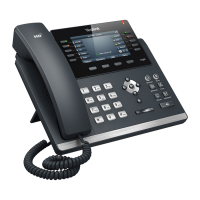Configuring Advanced Features
153
Specify a domain name to be used for the next query.
The IP phone picks the first record, because its order of 90 is lower than 100. The pref
parameter is unimportant as there is no other record with order 90. The flag ―s‖
indicates performing the SRV query next. TCP will be used, targeted to a host
determined by an SRV query of ―_sip._tcp.example.com‖. If the flag of the NAPTR record
returned is empty, the IP phone will use "sip:user@example.com" for the next NAPTR
query.
SRV (Service Location Record)
The IP phone performs a SRV query on the record returned from the NAPTR for the host
name and the port number. The sample of the SRV records for reference:
Priority Weight Port Target
IN SRV 0 1 5060 server1.example.com
IN SRV 0 2 5060 server2.example.com
Parameters are explained in the following table:
Specify preferential treatment for the specific host entry. Lower
priority is MORE preferred.
When priorities are equal, weight is used to differentiate the
preference. The preference is from highest to lowest. Again,
keep the same to load balance.
Identify the port number to be used.
Identify the actual host for an A query.
SRV query returns two records. The two SRV records point to different hosts and have
the same priority 0. The weight of the second record is higher than the first one, so the
second record is picked first. The two records also contain a port ―5060‖, the IP phone
uses this port. If the Target is not a numeric IP address, the IP phone performs an A query.
So in this case, the IP phone uses ―server2.example.com" for the A query.
A (Host IP Address)
The IP phone performs an A query for the IP address of the target host name. The
sample of an A record for reference:
IN A 62.10.1.10
Outgoing Call When the Working Server Connection Fails
When the user initiates a call, the phone will go through the following steps to connect

